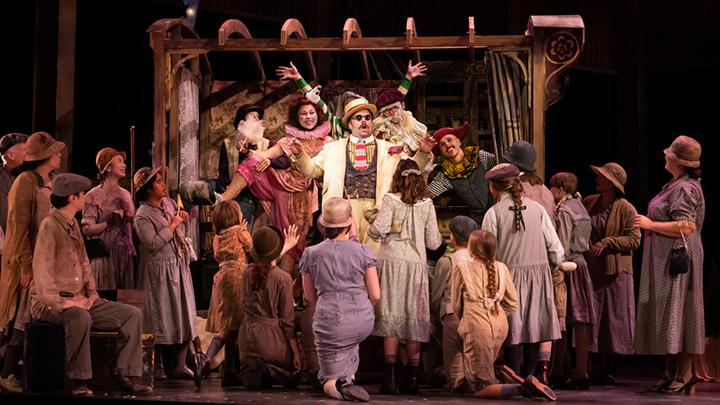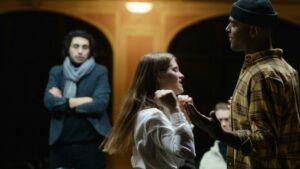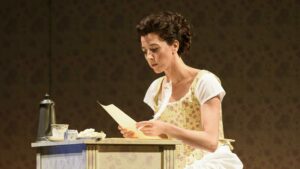Two of this summer’s four operas deal with love that turns clowns into killers, gods into clowns, virgin goddesses into strumpets, beauties into bears and nymphs into starry constellations. You can try to quell love, banish it from your life, but it will come back with a vengeance and mess you up!
Francesco Cavalli’s La Calisto (1651) deals with many forms of love – including lesbian love (!) – and how even the gods are subject to its follies and humiliations. In Giovanni Faustini’s loose adaptation of Ovid’s Metamorphoses, the titular nymph is a follower of the chaste moon goddess Diana and has abjured the company of men. Calisto attracts the lust of the god Jupiter (Giove) who makes moves on her accompanied by his wingman Mercury. Calisto contemptuously rejects the god’s advances. Ever resourceful and determined, Jove disguises himself as Diana the huntress and lures Calisto to a secluded grove where he/she plies her with kisses and caresses and something sweeter though Calisto can’t spell out what that is exactly. Whatever that was, Calisto wants more of it, going from virgin to slut in 3.5 seconds. When later the nymph approaches the real goddess Diana with her newly awakened desires, Diana is horrified and banishes her from her retinue. Calisto is left bewildered and heartbroken at Diana’s seeming change of heart and rejection. This is really spicy stuff for 1651 and I was certainly quite titillated by it in 2024!
Meanwhile, the chaste Diana has her own forbidden love – she returns the adoration of the shepherd Endymion and lures him to a mountain top for some moonlight hanky-panky. Complications ensue with Diana’s former lover the demi-god Pan and the Jove’s wife, the jealous Juno, both catching on to their former lovers’ extracurricular romantic interests. Calisto gets transformed into a bear by the vengeful Juno. Meanwhile Diana, being caught with her mortal lover and conscious of maintaining her pure image swears that their love must continue but chastely – kisses only (and no tongue). Calisto eventually is freed from her bearish bondage and is translated to the firmament as a starry constellation.

Cavalli’s music covers a wide range of styles and modes, sometimes dance-like for the satyrs and sylvans, lyrical love odes sung by Endymion, mocking serenatas – it’s full of melody and variety. The extant score of La Calisto is something of a skeleton: there are two staves – one with the vocal line and the other with what seems to be chord indications from which an instrumental accompaniment would be improvised. An orchestration must be made so that it can be performed. Luckily Robert Ainsley, the artistic and general director of the Glimmerglass Festival, is also a musicologist and conductor. He fashioned a performing edition that used a mixture of Renaissance and modern instruments but employed a larger consort than the half dozen or so used in the Venice premiere. It was a stylish, sensible and well-balanced performing edition which Ainsley conducted with great verve and style. He also instituted what seems to me sensible cuts to the score (which would run over four hours otherwise), resulting in a performance time of a little over two and a half hours.
Director Mo Zhou provided a nice balance of seriousness and humor suggesting that Calisto is making the best of a bad situation when she discovers that her actual seducer was Jove. There is sadness and regret beneath the rueful submission. When she is translated to the heavens as a constellation, it is seen as a kind of death by transfiguration. The staging was fluent and elegant framed by the colorful sets in Fauvist style of Charlie Corcoran and the evocative lighting of Amith Chandrashaker. The costumes by Carlos Soto were wittily stylized and emphasized character. The choreography of Eric Sean Fogel blended into the movements of the singers seamlessly.
The cast was mainly young singers. In the title role, soprano Emilie Kealani sounded appropriately very young but also a little shallow and brittle at times. Immaturity is not a wrong way to go and her performance had a naïve charm. The real star was mezzo-contralto Taylor Raven as Diana/Jove as Diana. Raven has an imposing stage presence and a dusky deep mezzo that blended silken coolness with seductive warmth creating a hot/cool dynamic suitable to the fallible goddess. Equally impressive was the very young and new Filipino countertenor Kyle Sanchez Tingzon whose elegiac and plaintive timbre as Endymion seduced the ear and touched the heart. As Juno, Met mezzo-soprano Eve Gigliotti was a force to be reckoned with handling the high tessitura heroically (the part has been cast with sopranos – in the 1996 Glimmerglass production, a very young Christine Goerke, then a Young Artist, sang Giunone). Gigliotti was also an amusing Ruth in The Pirates of Penzance at the matinee performance prior to Calisto.
Craig Irvin was a strutting, macho entitled Jove with a beery bass-baritone and bearish, imposing presence abetted by his shifty sidekick Mercury, the deft baritone Schyler Vargas. (Irvin also strutted and heaved his hairy chest to good effect as the Pirate King in Penzance). In purely comic roles, Winona Martin scored as Linfea, a Diana follower who decides to abandon chastity for a change of pace who is pursued and teased by Amanda Sheriff, sassy and funny as a Young Satyr. Sanchez Tingzon, Kealani, Martin and Sheriff are all members of Glimmerglass’ Young Artist Program.
Ruggero Leoncavallo’s I Pagliacci was performed as a standalone piece with an intermission after “Vesti la giubba.” Brenna Corner’s production is set in the Depression era circa 1930 (similar to the current Met production) and is framed as a flashback. A lone middle-aged man enters what seems to be a warehouse (designed by James Rotondo) filled with the wooden trailers and platforms of a circus or traveling variety act. After opening a trunk and finding a rumpled clown costume, ghosts from the past emerge from the shadows and we hear the opening strains of the famous Prologo aria, “Si può? Si può?” and realize the mystery man is Tonio. The lighting changes and the stage fills with peasants and villagers (who enter singing from the aisles of the theater) and the action of the opera proper begins. The rest of the action is pretty traditional and by the book though a gun was used as a weapon in place of the whip wielded by Nedda and the knife fatally wielded by Canio. The staging of the commedia dell’arte was witty with a fun use of props and expertly done.
The cast was very adept. Baritone Troy Cook, formerly a barihunk, was a resonant Tonio with excellent legato phrasing and verbal pointing making a meal of the prologue and scoring points throughout the opera. As Nedda, Amber M. Monroe was a revelation – this is a lush, juicy spinto soprano with sheen and float for the lyric passages (the love duet) but lots of power for the second act confrontations. The George and Nora London Foundation Competition prize winner is a young talent to watch out for – the voice is very much in one gorgeous piece and is used with intelligence and musicianship. Tall baritone Jonathan Patton, a Washington DC opera fixture who specializes in contemporary music, was a successful businessman looking Silvio in his white three-piece suit and straw hat. He has a beautiful upper register and firm tone, but I felt he could have used some lessons in Italianate phrasing from his older colleague Troy Cook. Monroe sounded seductive in the love duet whereas his responses were on a more mundane level.

As Canio, tenor Robert Stahley revealed a major instrument with a sadly incomplete technique. He is a large man with a large ringing voice with a broad middle register who hasn’t figured out how to connect this middle register to the top of the voice. Yes, our old friend passaggio problems… The top is there but he has trouble getting to the notes without breaking the line by hooking into them or lunging at them with force. Unwisely, in the opening aria “Un grande spettacolo,” he attempted the unwritten optional high B-natural on “A ventitré ore!” and it strangulated and broke on him. Other high notes (in this not very high role) also came out strained and forced. The size and quality of the voice is evident and he acted well showing Canio’s scary trigger temper underlying a deceptively genial outward manner. Glimmerglass music director Joseph Colaneri is an experienced and deft hand at this kind of score and it all held together beautifully.
I had missed the Glimmerglass Festival for about a decade and I was heartened to see the high caliber of all four productions done this summer. The orchestra played well, the design, direction and lighting of the productions were on point and the singing for the most part really fine. La Calisto would not have embarrassed a small international festival and the Pagliacci was provocative, theatrical, and musically worthwhile. The other productions included G&S The Pirates of Penzance which was a breezy delight and Kevin Puts’s Elizabeth Cree which had a wonderful production and performances wasted on a rather pointless and unconvincing story which at the end fell apart.
Next summer for Glimmerglass’ 50th anniversary season, they are performing Tosca, Sondheim’s Sunday in the Park with George, The Rake’s Progress, The House on Mango Street (a world premiere), and another world premiere: The Odyssey, music by Ben Moore.
Photos: Sophia Negron







Comments